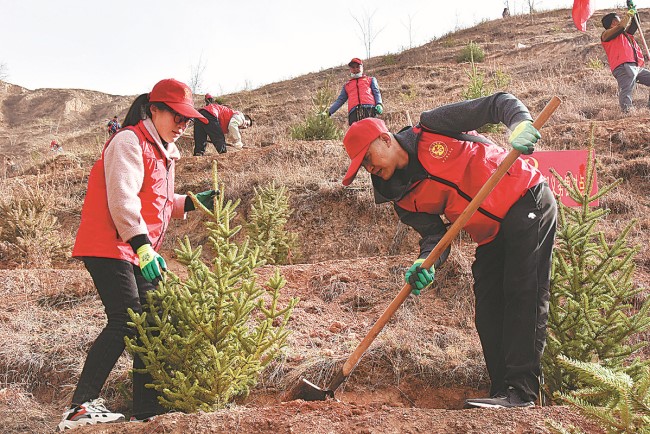Greening gives Loess Plateau farmers bright prospects

Civil servants plant trees on the Loess Plateau in Zhenyuan county, Qingyang, Northwest China's Gansu province, last week. [Photo by Zhang Fan for China Daily]
Li Wenjun, who runs a seedling business, says a mass greening project in his hometown in Northwest China's Gansu province saved his business a decade ago and is now giving local people a prosperous future.
Li's hometown of Wuqi in the city of Qingyang, sits on the Loess Plateau, which covers more than 250,000 square kilometers on the middle and upper reaches of the Yellow River, encompassing the provinces of Gansu, Shanxi and Shaanxi and the Ningxia Hui and Inner Mongolia autonomous regions.
The plateau used to be plagued by chronic soil erosion, with tens of millions of metric tons of mud and sand washed into the Yellow River every year, making up most of the silt that gave the river its name.
Thanks to water and soil conservation efforts over the past decade, particularly afforestation projects along the river, the amount of sand running into the Yellow River in Qingyang has dropped significantly.
In the 1980s, more than 168 million tons of sand used to run into the Yellow River every year, accounting for 10 percent of the total along the whole river. But that has now dropped to 69.97 million tons a year.
A mass greening project in Qingyang that locals have dubbed "Another Ziwuling" has been one of the main drivers of that improvement.
Ziwuling, a mountainous area on the border of Shaanxi and Gansu, is the largest natural forest in the middle of the Loess Plateau.
The project was launched in Qingyang in 2013 with the aim of doubling Ziwuling's area through afforestation. The city government announced that at least 66,700 hectares of forest would be planted every year and provided 10 million yuan ($1.57 million) a year to encourage local seedling businesses.
"The project saved my seedling business from dying out," Li said. "And preferential policies from the local government even boosted the business. In 2014, I established a farmers' cooperative, bringing higher incomes to local people through greening."
A farmer can earn 120 to 159 yuan a day planting trees, Li said, adding he has also signed contracts with farmers who rent out bare mountains for greening.
"Those farmers will receive a bonus every year if the forest earns a profit," Li said. "To us, the forest is a green bank with the promise of future profits."
To protect the forest from fires and illegal logging and to take better care of seedlings, Qingyang has also employed thousands of forest rangers, most of whom are local farmers.
"We work five days a week and receive an annual subsidy of 8,000 yuan," said Guo Zhanwei, 50, a forest ranger from the town of Yima who has worked as a forest ranger since 2018. "For a farmer of my age, the compensation is attractive and more than I can earn from farming."
Seventy-six greening companies have participated in the project, along with 134 farmers' cooperatives, according to the city's forestry department. More than 273,000 farmers have been involved in the project, with 159 establishing afforestation businesses.
In the village of Duhe, Ma Jianlong is one of a number of farmers who have benefited from greening. Since 2014, Ma has employed several villagers and planted more than 4 million pine trees in the surrounding mountains-80 percent of which have survived.
"When I was a child back in the 1970s, our village was surrounded by bare mountains, with grass dotted here or there only in summer," Ma said. "In the dry season, my parents had to join in a long line to collect muddy water from a small pool at the bottom of the hill. That was the drinking water for the whole family."
Thanks to the afforestation project, he said the mountain spring water has seldom dried up in recent years.
"Our village now has several wells. All are no deeper than 50 meters," Ma said. "About a decade ago, water could only be found at a depth of 70 meters."
Statistics from Qingyang's city government show that 487,000 hectares of forest were planted between 2013 and 2020. The city's forest coverage rate, just 11.3 percent in 1993, reached 25.8 percent in 2020.
A greener city has also led to improved air quality. According to the city's weather bureau, Qingyang had 340 days with fairly good air quality last year.
The concept of green development has also boosted ecotourism, helping to further increase people's incomes.
Qingyang has 120 forest family inns and 87 forest farms. Industries in the city's forested area, such as Chinese herb planting and poultry farming, now have annual output valued at more than 616 million yuan.
In the next three years, Qingyang aims to enhance forest quality by selecting various types of seedlings and improving their survival rate, said Zhao Yaping, director of the city's forestry and grassland bureau's afforestation office.
The bureau has also drawn up a five-year rural greening plan.
"Every year, we will plant more trees and improve the vegetation coverage in at least 230 villages," Zhao said. "Villages in Qingyang will be greener and more beautiful."
